Peace in the Valley
Okay, it’s true that Monticello, New Mexico isn’t a full-on ghost town. Some folks do indeed live there. But it’s got its fair share of old, empty structures, including an impressive adobe school built by the Works Progress Administration (WPA). In 1980, Philip Varney included Monticello in New Mexico’s Best Ghost Towns because of its “extraordinary charm.” Well, in this case, perhaps not much has changed over 34 years because Monticello remains extraordinarily charming. Judging from Varney’s photos, some buildings look better and some perhaps worse. However, if you stopped for a couple hours to eat lunch on the shady steps of the school and listened to the birds sing while the wind blew gently through the tall cottonwoods, as I did, and then explored the rustic little plaza, you might think about buying a secluded retreat in Monticello, as I also did.
Monticello, in southwestern NM, is 25 miles northwest of Truth or Consequences, not far from Cuchillo, and was originally founded in 1856 as Cañada Alamosa. The name honored the town’s cottonwood-lined canyon. The Alamosa River flows alongside. Clearly, in the green, 23-mile-long Monticello Valley within which the town sits, cottonwood trees have always been a big deal.
Early on, Cañada Alamosa was the headquarters of the Southern Apache Agency. By 1870, 500 Apaches lived in the area and Cochise, the Apache leader and namesake of Cochise County, AZ, brought his entire Chiricahua Band in with him in the winter of 1871. But, in 1874, when the agency was moved a handful of miles northwest to the Ojo Caliente Reservation, near present-day Dusty, in what’s now known as the Monticello Box Canyon, the Apache were dispersed. Almost 20 years later the town became known by the much less poetic moniker Monticello.
In 2003’s Ghost Towns Alive, Linda Harris says the name change was the result of postal system bureaucracy. The story goes that in 1892, Alphonse Bourguet and his brother, Aristide, French emigrants, wanted to establish a post office in Cañada Alamosa. However, the policy of the day dictated that postal names be a single word. Alphonse had once been postmaster in Monticello, NY and Aristide must’ve figured that worked pretty well the first time because he submitted Monticello as Cañada Alamosa’s replacement. This is all similarly recounted in The Place Names of New Mexico.
But I have read other accounts, including in New Mexico’s Best Ghost Towns, stating that John Sullivan was the town’s first postmaster, also from Monticello, NY, and he made the change. However, I think this is now considered incorrect. Some Bourguet’s and Sullivan’s still live in Monticello. Perhaps they can tell us! Whatever his role, John Sullivan’s home was reportedly a stage stop, claimed to be the first in Sierra County. Sullivan’s place still stands off Highway 142, which leads into town and passes the plaza. For some reason, New Mexico True says his home was the San Ignacio Catholic Church!
The Monticello Valley has always been a ranching and farming community and it remains so today, producing organic vegetables and award-winning balsamic vinegar. But it’s true that it’s not as bustling as in the past. The large Monticello Public School, mentioned earlier, has been reduced to a picturesque shell. Built in 1935, it’s said the school burned down when a student’s chemistry experiment exploded. However, that may be nothing more than a rumor. The plaza, quiet and empty during my visit, once provided a thick-walled adobe fortress complete with gun holes to guard against Apache attacks. A couple homes on the outskirts of town, one fairly large, appear long-abandoned, with vintage vehicles parked outside in various degrees of decay. Of course, I was in heaven.
On the other hand, the San Ignacio Catholic Church, built in 1867, is well-maintained and lovely. Located on the north side of the plaza, services are still held there. There may yet be a dried-out pump organ in the choir loft. Restored territorial-style homes with corrugated tin roofs peak from behind lush greenery. What appears to have once been an antique store sits silently to the east of the plaza. Quite derelict in a photo in Varney’s book, it’s clearly been restored, even if it’s now vacant again. Within its cool, blue walls are many of the antiques that must’ve once been for sale and the ceiling shows several large, beautiful vigas running lengthwise. Outside are a low, weathered, wooden patio and an old bench. Anybody want to go in on the place with me? That’s it below.
In 1910, at its peak, Monticello had 573 residents and there may have once been more than 1,000 families throughout the valley, which includes the adjacent town of Placita. The 2012 census has the population at 135, yet most folks probably don’t live in town year-round. I saw only a few people, all of which passed by in cars or trucks as I took photos along the roadside.
I attempted to get to the cemetery southwest of the plaza, but after crossing the shallow Alamosa River ran into several private property signs without a graveyard in sight. It’s a shame, because I hate to miss an old cemetery. But it does provide an excuse for a return visit. As if I needed an excuse! To further prove that point, as I left, four cow ponies crested the rise beside the cars pictured below. You might be able to make out the hawk soaring through the upper right of the frame. Extraordinarily charming indeed.
Most information for this post came from the NM ghost town books of Varney and Harris, with a bit from The Place Names of New Mexico. The now defunct website Viva New Mexico, and Legends of America were also useful. Ghosttowns.com has a couple interesting tidbits and Bestplaces.net presents demographic info from 2016. New Mexico True, the state’s official tourism website, gets much more wrong than right, but at least they tried.
John Mulhouse moved to Albuquerque in 2009 after spending the previous decade in Minnesota, Georgia, Tennessee, and California. He loves the desert, realizes it doesn’t care too much about him, and thinks that’s all as it should be. More of his documentation of the lost, abandoned, beaten, and beautiful can be found at the City of Dust blog and the City of Dust Facebook page.

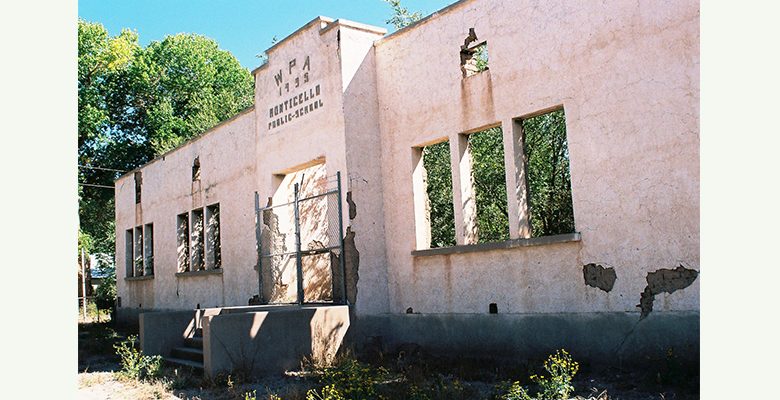
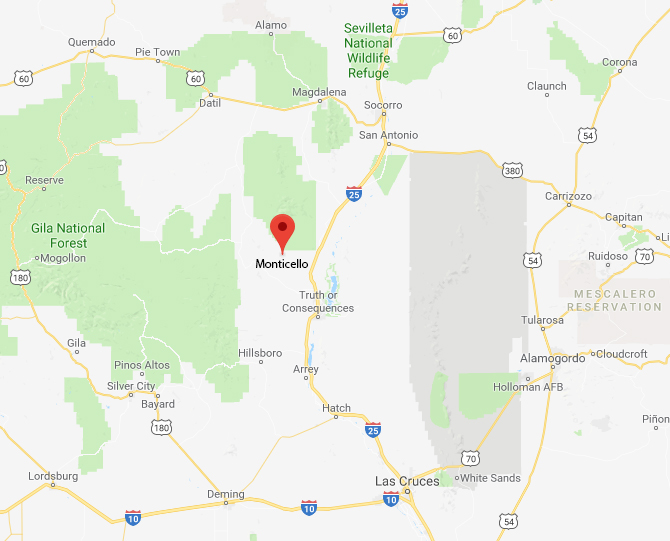
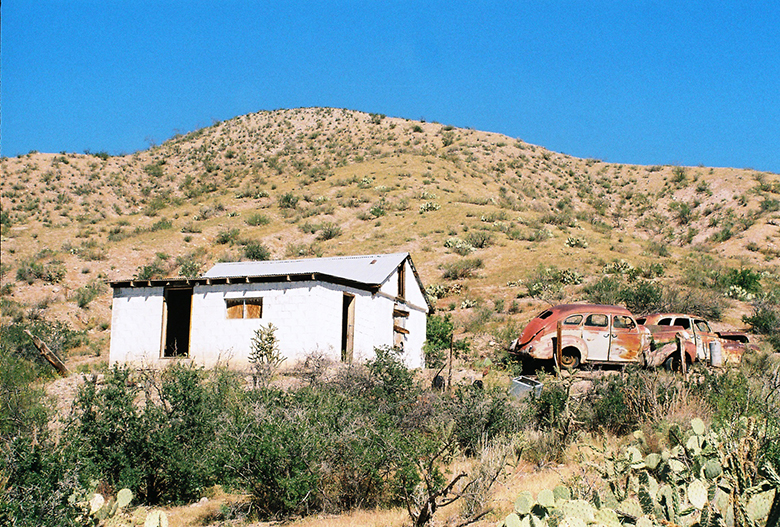
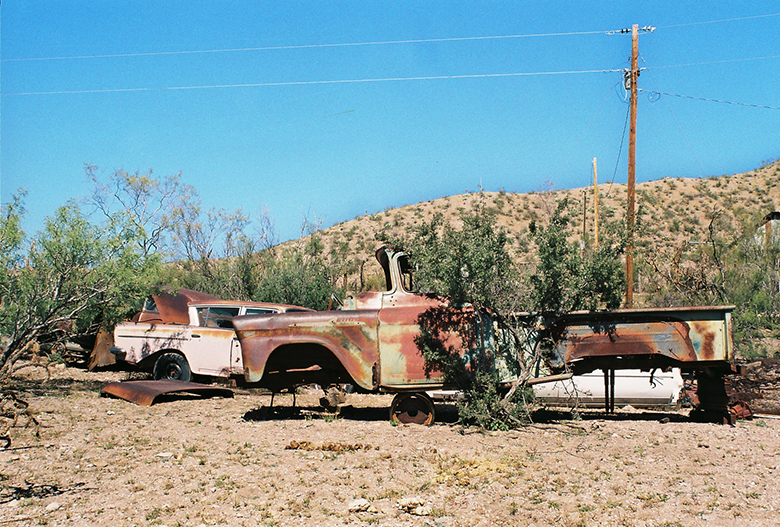
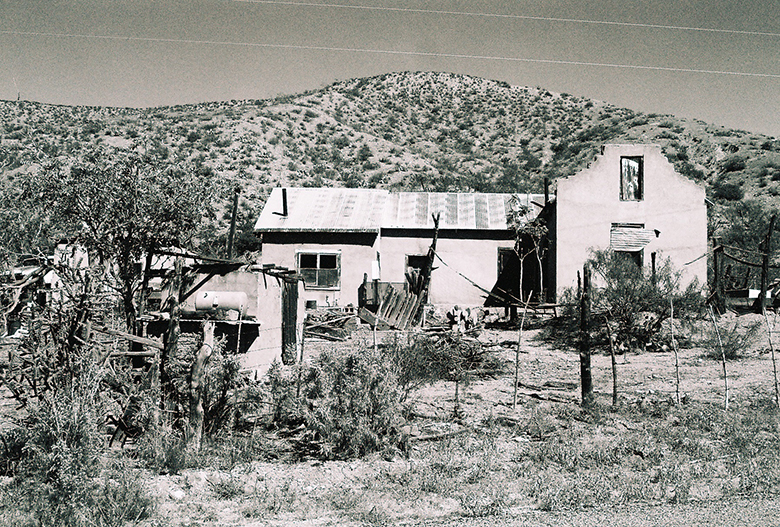
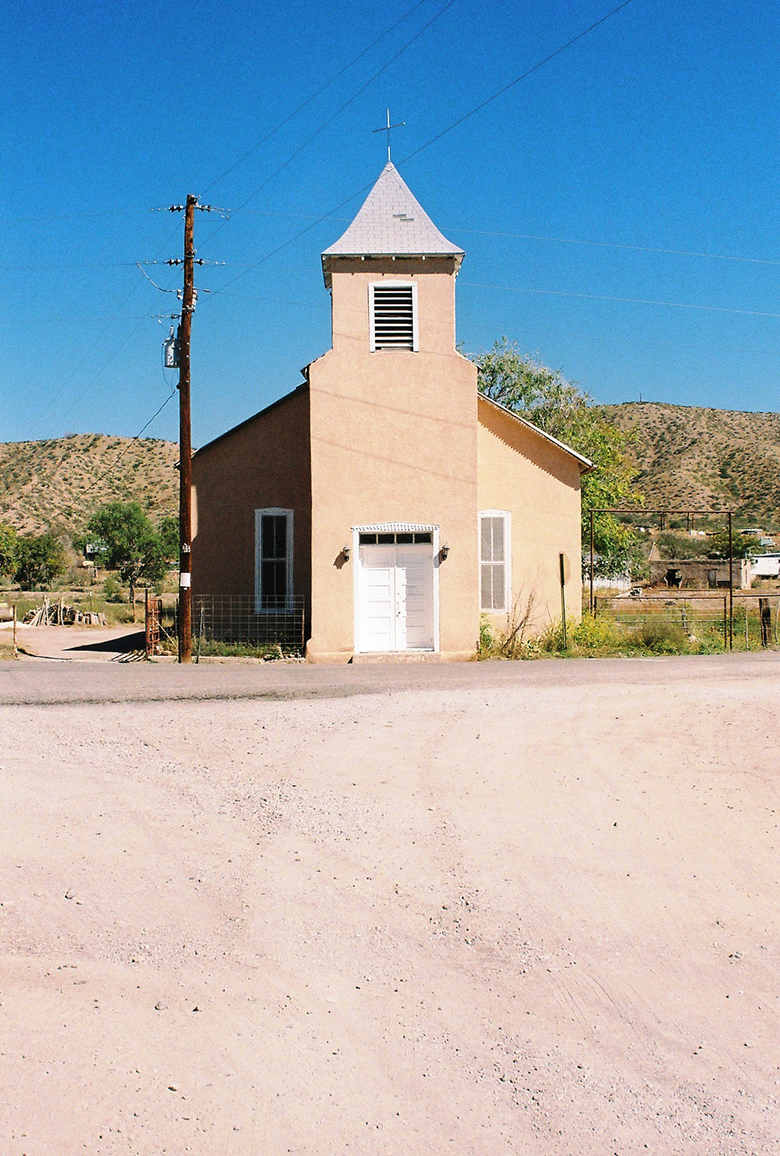
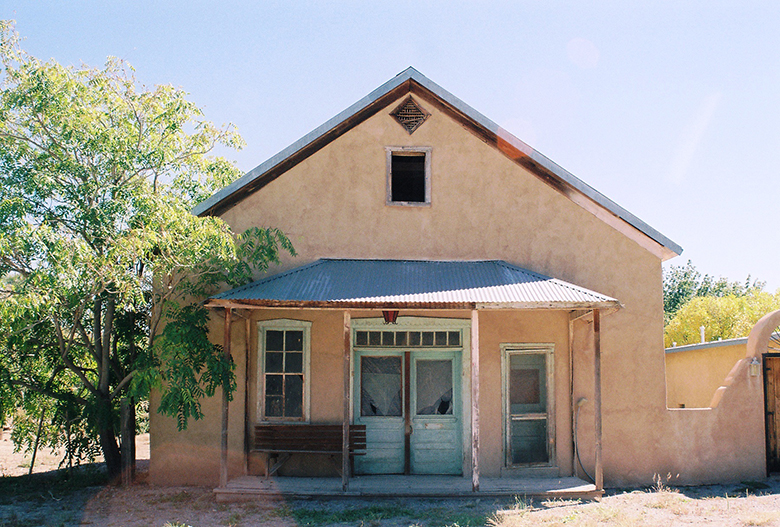
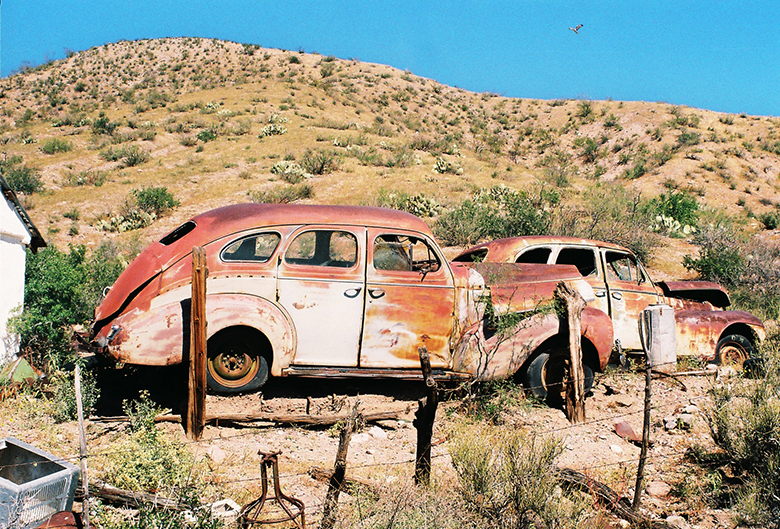
That’s amazing history. Haven’t been there since I was 16.
I love to drive out there. There is something special about it. I can’t explain it. Every time I go, I hate to leave. It’s a hidden valley. Someone has opened a retreat there now. Let me know when you are coming again and I’ll meet you there!!!
My name is Gwen
My grandparents and great-grandparents lived there. My mother was raised there, she went to school there. If you want the past history of Monticello I only have two aunts still alive and they are both in there eighties still with good memories.
I remember going to help my grandparents clean the church.
We used to play in the ditch and eat apples. So so many precious memories to list on here. Also the winery is my grandparents old house..
Gwen, My family (Trujillo) was one of the eight original founding families of Monticello. Unfortunately all of the family members that I know of have passed. If your aunts are still alive I would love to have a conversation with them regarding their memories. E-mail me if you have an interest in my request and we can exchange phone numbers. Herminio Trujillo
My family (Bourguet’s and Sedillo’s) was originally from there and I have a recording of my mother’s (she grew up there, born in 1913 and passed away in 2016 at 102 years young) accounts of how it was back then
My family the Montoya were also from there my father and all his siblings all went to school in monticello many fond memories my uncles house is right next door to the former post office.
Cyndee – related to Lucy Bourguet? She was my grandmother. My mom was Mable Sullivan.
Hi Cyndee,
Renee here. I think of you often. I’m sorry to hear about the loss of your mom. Please contact me at reneefgarcia@aol.com
My family, Sullivan, was THE founding family!
Think you might be mistaken. The story doesn’t add up that a Sullivan randomly decided to create a post office and change the name to match post office requirements. The Bourguets were post office masters before even going to the town… And the post office was established within 1 year of them arriving? Additionally lived in the house tied to the post office and was owned by a Bourguet until the 1990s when the post office closed and was sold. Don’t get me wrong, lots of Sullivan influence.
Hi Grant,
I also think the story of Bourguet’s opening the post office is the correct one. It’s referenced in “Ghost Towns Alive,” and described in some detail in Robert Julyan’s “The Place Names of New Mexico.” I just mentioned the Sullivan story because it appears in Philip Varney’s iconic “New Mexico’s Best Ghost Towns: A Practical Guide.” Although that’s about 40 years old now. Anyway, I figured I’d relate them both, but after mentioning the Sullivan founding I added, “However, I think this is now considered incorrect.”
So, yeah, your reasoning makes sense to me!
Thanks for your message! John
David I used to work for Victor years ago and me and Joe of windmills limitar and Victor planted hudge rounds of umbrella willows where chile used to grow seen in 2002 growing well and how’s the stailon name blue?
My grand mother was Paulina Trujillo who was married to John Trujillo. Their oldest son buried in the cemetery in Monticello. My mom Mary Alice Trujillo also went to school in Monticello. Many of my moms family still live in or around the Winston area. Please email me if any of that interests you. Like earlier comments I also remember playing in the ditch / stream flowing through the valley and remember its tranquility and beauty.
Hello I’m also related to Trujillo’s. My great great grandparents were married in Monte in 1875. I’m also related to Silva, Trujillo, Torres, Romero and Chavez and Baca. You can email me at espanarose58@gmail.com
I’m a Trujillo my great grandfather was Pedro Celestino Trujillo my name is Daniel Trujillo Sr. Contact me.
Hi Gwen, My great great grand parents got married there in 1875 Maximo Apodaca and Prajedes Torres. I would love to know more about the history there. Maybe your aunts knew who they were or the names. I’m also related to Silvia’s, Trujillo’s’, and Romero’s. Also Baca and Chavez.
My grandparents were from there also. Marcos Lino Gabaldon and his wife Mercedes Gabaldon. My mother was Josephine Gabaldon.
Thank you for this interesting article. The Post Office has an official list of post masters & locations.
My maiden name is Bourguet. My grandparents, Richard Bourguet and Lucia Sanchez were both born, raised, and married there. I am also related to the Grandjeans and the Sullivan’s. I have taken my mom and all of my children back to experience our history. Thank you for this wonderful artical! It made my day!
My dad’s mom, Isabel Chavez, was born there in 1906. Her parents were David and Eufrasia (Perea).
We would go visit her every year in Belen where she lived when I was young. i remember walking in
the warm waters of the box canyon one year. I have most of your last names in my family tree!
Monticello is now the site of a company that makes very high-end balsamic vinegar!
My family is also Bourquet. My grandmother was Nellie Bourquet. I am also related to the Sullivan’s and the Grandjeans.
Sondra Mary Sullivan-Koenig
I am the daughter of Edward Sullivan oldest son of Charlie Sullivan great grand daughter of John Sullivan.
Monticello I believe still has a huge part to play in NM. Every one that goes their finds peace for their soul.
It is truly a place you will never forget. The people that are there are the salt of the earth. They don’t come any better.
Wasn’t Charlie the sheriff in TorC a long time ago? I lived in TorC from 1951 to 1969. Graduated from HSHS in 1957.
Now Victor Sullivan not around who the heck is carrying on the tradition big bond fire’s and get together cooking feast and how me and Joe and Victor trees doing, just a few tops off the umbrella willows by the old sweet corn field next to apricot giant tree is where we found those trees that are now growing behind Victor Sullivan old place in the permanent pasture, two tractor ?? Darell what the heck happened to the stailon name blue?
My mother Callie Sanchez was born in Monticello on my Grandfathers (Andrian Sanchez) ranch up the canyon from the village of Monticello. Her and my Dad were married in the little church there. Both my grandparents were born in Monticello when New Mexico was still a territory!
My grandparents also had a house in the village of what is now the home of the balsamic vinegar company. My grandfather was the oldest living veteran and memorialized in the TorC museum where he retired! Loved visiting his ranch during summer vacations. Sad that his ranch was sold to a corporation. My aunt lived in Monticello until recently. Beautiful area with so much history!
My ancestor was Juan Nepomecino Trujillo Born in Socorro. From what I understand, after his father died, he and his mother lived with Juan Montoya who had married Juan N. Trujillo’s older sister Maria. From Socorro they moved and lived for short periods of time in San Pedro, Paraje, and San Ygnacio De La Alamosa, before settling in Canada De Alamosa (Monticello). Juan Trujillo’s farm and orchard was located about 2 – 3 miles up the canyon. According to family legend Juan N. Trujillo and Juan Montoya founded Canada de Alamosa, with several of his relatives founding the towns of Cuchillo, Chiz and Chloride. I don’t know if this is true, but have found indications of other family legends to be correct. In either case the Trujillo’s were at least very early settlers to these areas.
Hi John my great great grandfather was Juan N . Trujillo his son Pedro Celestino Trujillo was my great grandfather, Federico Trujillo my grandfather, and Freddie Trujillo Jr.my dad I think we are related, please respond.
My grandmother was born in Monticello and her last name was Armijo. My great grandparent’s last names were Armijo and Chavez. Also, in my ancestry are the names Montoya, Alderete and Baca that lived in the area. Is anyone here have those names as well in their ancestry?
I have Baca andvChavez. My uncle and his family, The Tafoyas are from Monticello where theybwere born.
What’s your grandmother’s first name? What are your great grandparents names. I have Armijo and Chavez on my Tree. My direct line is Romero and Torres. Those are my 3rd great grandparents names. So my 2nd great grandparents got married in Monticello back in 1875. After they marry they left. I’m sure the Romero’s and Torres stayed there.
Rose who the one I knew was 85 and had a rocking old western bar next door, and the story of stack of catus layer and stack for animals feed, my self Victor Sullivan supply the propane torch and the bulls left the patch with out Thier mouth filled with stickers
I really enjoyed everyone’s comments, I’ve read all I can about Monticello. My great-great grandparents, Thomas Jefferson Hill and Maria Sarricino, arrived in Monticello after 1861 or there abouts. One of their sons, Jose Tomas Hill married Rufina Chavez, their son , my namesake and grandfather, Louis Chavez Hill, married Laura Chavez, and their son, Josebenito Chavez Hill, my father. I am a Californian-New Mexican and drove out to Monticello in 1972 and 2003. I will be there again before I get to 100, I promise.
I was looking for any information anyone may have about Manuel Ruiz born in Monticello December 24, 1893. Manuel married Josephine Chavez born 1903 also from the same area. Moved to the San Diego, California area in 1933 after having 5 kids in New Mexico prior to that
I lived there. My dad also lived there since 1970
Was your dad John J. Chavez?
Thanks for the memories of when I lived there, in the 70’s. Before the days of balsamic vinegar, when there was a cantina in the square, before the roads were paved and named and Romolo still lived in the house with all the old cars.
Rose old bar and rose hips too, rest my younger version of me water department for Victor Sullivan not in the 70s , clean up hot ditch 14 Miles just to have a better Flo heading out to the fields
My father name was Prospero Montoya, a WWII vet who fought in New Guinea, his brother Edras was a prisoner in the Bataan Death March, after a day he escaped and witness a lot of atrocities by the Japanese. He hid for 4 years in the Phillipene mountains. He has a fantastic tale of survival. he and my dad and the rest of their siblings were born in Monticello. As well as my grandparents Polidoro Montoya and Barbarita Silva Montoya. One of the Montoya family’s still own the land. We have deep roots in that valley.